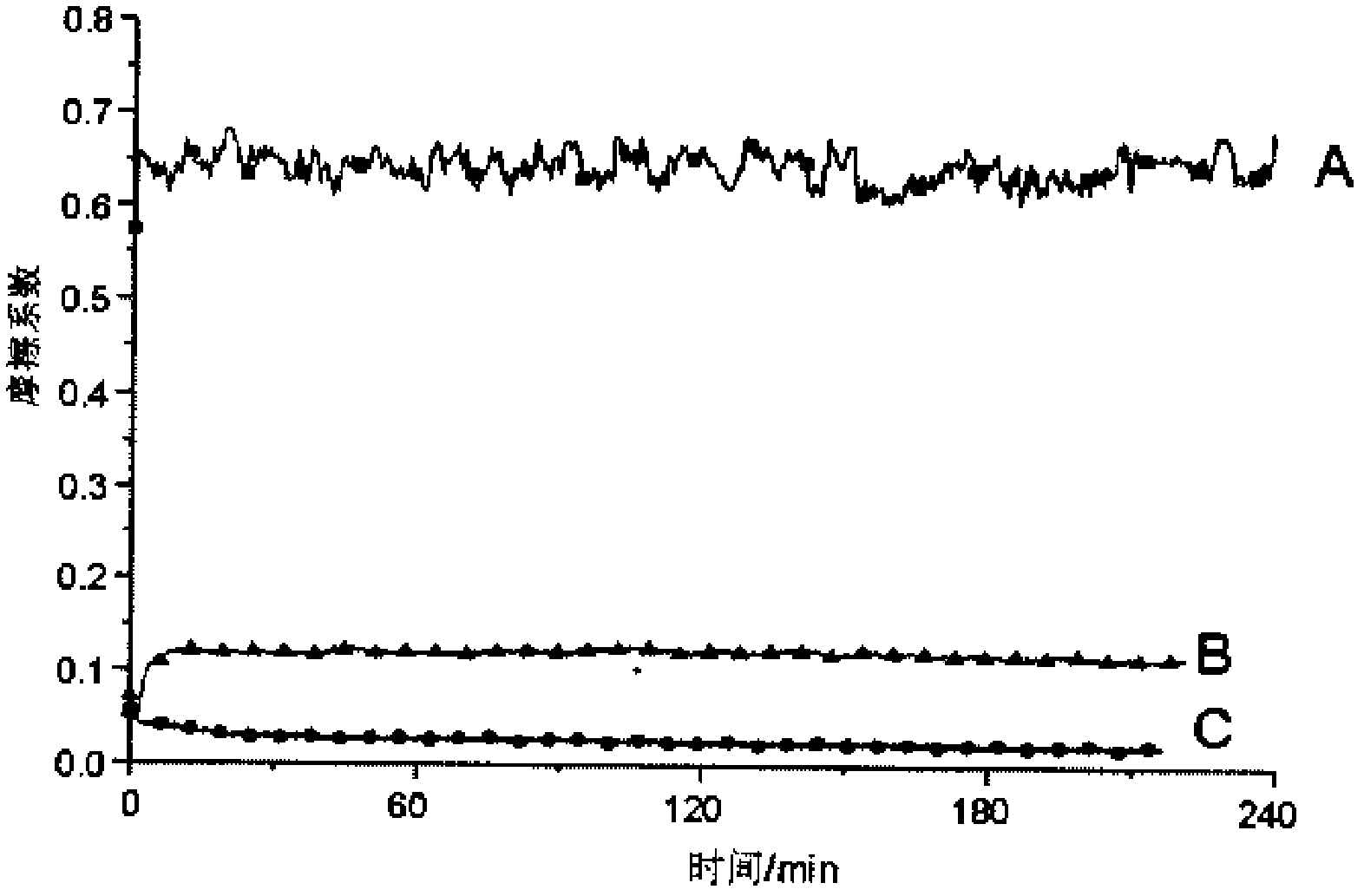Method for reducing friction coefficient by surface finishing
A friction coefficient and surface modification technology, applied in the direction of engine lubrication, engine components, mechanical equipment, etc., can solve the problems of reducing friction coefficient, low silane graft density, thin coating, etc., to achieve good wear reduction effect and practicality strong effect
- Summary
- Abstract
- Description
- Claims
- Application Information
AI Technical Summary
Problems solved by technology
Method used
Image
Examples
Embodiment 1
[0018] The friction pair was ultrasonically cleaned with acetone, tetrahydrofuran, N,N-dimethylformamide and distilled water for 15 minutes each, and then dried. Then irradiated with ultraviolet for 1.5 h, and applied 10 wt% ethanol solution of perfluorooctyltrichlorosilane to the friction pair and dried at 60°C. Using pure water as lubricant, start the main engine, and the friction pair starts to work. Under the contact pressure of 400MPa, the measured friction coefficient is 0.12 (such as figure 1 In the curve B), and can be maintained for about 3.5 hours. Under the same working conditions, the friction coefficient of the friction pair not modified by this method is 0.65 (such as figure 1 shown in curve A).
Embodiment 2
[0020] The friction pair was ultrasonically cleaned with acetone, tetrahydrofuran, N,N-dimethylformamide, and distilled water for 25 minutes each, and then dried. Then treated with oxygen plasma for 1 h, 5wt% ethanol solution of perfluorooctyltrichlorosilane was coated on the first friction body, and dried at 60°C. , 8 wt% ethanol solution of decyl trichlorosilane was coated on the second friction body, and dried at 40 °C, and the coating was repeated 6 times to make the coating thickness reach 120 nm. Using oil as lubricant, start the main engine, and the friction pair composed of the first friction body and the second friction body starts to work. Under the contact pressure of 340MPa, the measured friction coefficient is 0.03 (such as figure 1 shown in the middle curve C). , and can be maintained for about 5 hours. Under the same working conditions, the friction coefficient of friction pair not modified by this method is 0.73. (such as figure 1 shown in curve A).
Embodiment 3
[0022] The friction pair was ultrasonically cleaned with acetone, tetrahydrofuran, N,N-dimethylformamide, and distilled water for 30 minutes each, and then dried. Then treated with oxygen plasma for 2 hours, 7wt% dodecyltrichlorosilane solution in toluene was coated on the first friction body, and dried at 50°C, and the coating was repeated 4 times to make the coating thickness reach 82nm. The ethanol solution of 10 wt % propyltrichlorosilane was coated on the second friction body, and dried at 40° C., and the coating was repeated 5 times to make the coating thickness reach 114 nm. Using liquid paraffin as lubricant, start the main engine, the friction pair composed of the first friction body and the second friction body starts to work, and the friction coefficient is measured to be 0.05 under the contact pressure of 600MPa (such as figure 1 shown in the middle curve C), and can be maintained for about 7 hours. Under the same working conditions, the friction coefficient of th...
PUM
| Property | Measurement | Unit |
|---|---|---|
| Thickness | aaaaa | aaaaa |
| Thickness | aaaaa | aaaaa |
| Thickness | aaaaa | aaaaa |
Abstract
Description
Claims
Application Information
 Login to View More
Login to View More - R&D
- Intellectual Property
- Life Sciences
- Materials
- Tech Scout
- Unparalleled Data Quality
- Higher Quality Content
- 60% Fewer Hallucinations
Browse by: Latest US Patents, China's latest patents, Technical Efficacy Thesaurus, Application Domain, Technology Topic, Popular Technical Reports.
© 2025 PatSnap. All rights reserved.Legal|Privacy policy|Modern Slavery Act Transparency Statement|Sitemap|About US| Contact US: help@patsnap.com


